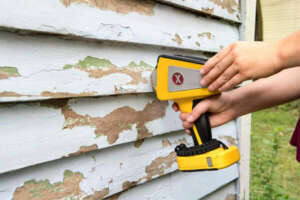Thanks to new funding from the National Science Foundation (NSF), researchers will co-create new tests and technologies alongside community health workers.
“The current system for discovering lead hazards in homes treats children like test instruments,” says Marya Lieberman, a professor of analytical chemistry at the University of Notre Dame. “Following this model, we wait until a child’s blood shows elevated lead levels,” she explains, “and then that triggers engagement from the city and the county.”
Lieberman is part of a team, which includes three other Notre Dame faculty members and many community health partners, that is working to rethink that system. And their bold new ideas have just received a major funding award from the National Science Foundation (NSF). The centerpiece of the funding is a new app that will speed access to resources and provide better data to health officials and policymakers.
Nitesh Chawla, the Frank M. Freimann Professor of Computer Science and Engineering at Notre Dame, will lead the team. Chawla, who is also the founding director of the University’s Lucy Family Institute for Data & Society, says that the idea for the project arose from the Michiana Community Health Coalition (MCHC), a series of Institute-sponsored meetings with community health professionals. Listening to those working on the front lines of community health provided insights about the “gaps” that keep scientific advances in the study of lead poisoning from improving health for members of the local community.
Kimberly Green Reeves, who directs Beacon Health System’s public outreach efforts, adds that “there are barriers to access all along the route from testing to treatment. After we test, we need to make sure families have easy and equitable access to the resources available from healthcare providers, governments, and health departments.” Green Reeves, who will serve as a key community partner in the project, adds, “We’re excited about the role technology can play in helping us communicate a clear message to the community in a timely way.”
Jay Brockman, who heads up Notre Dame’s Center for Civic Innovation, emphasizes that the principle of solidarity will guide the team’s process for developing new technologies. “Real change requires listening,” Brockman says. “We have to understand what is really going on in the neighborhoods to understand the barriers and co-create solutions people truly trust and use.”
Chawla adds that co-creation is especially important because lead poisoning disproportionately affects the most vulnerable members of the local community whose voices are often ignored.
“We know that lead poisoning occurs mostly in low-income and minority neighborhoods,” he says. “Lead poisoning makes the problems these neighborhoods face even worse by harming children’s development and adding additional barriers to their progress in life.”
Allison Zeithammer, Director of Communications for the City of South Bend, says the city is glad to be a key partner in the project as well. “As a municipal government, we see firsthand how the issue of lead poisoning can impact South Bend residents,” she says, “But we also see how complex the issue is. So we understand this kind of partnership that brings together health systems, health departments, and researchers who all want to create positive outcomes for residents.”
For Dr. Mark Fox, the Deputy Health Officer for St. Joseph County, the project is an important step in the community’s relationship with Notre Dame.
“Over the last five years, there has been renewed attention to lead risk in St. Joseph County, and Notre Dame’s Lead Innovation Team has helped increase testing,” he says. “Now we can shift our focus upstream to ensure that every child born in St. Joseph County has a safe home to come home to. Notre Dame’s expertise in chemistry, innovation, and data science will give us a clearer picture of where the risks lie so that we can prepare and follow up appropriately.”
He adds, “It’s a powerful example of what can happen when the University brings its intellectual capital to serve society.”
To learn more about Notre Dame’s ongoing partnership with local health professionals, visit the Michiana Community Health Coalition (MCHC) or contact its conveners, Jessica Brookshire, Jen Lefever, and Jill Pentimonti.
Contact:
Brett Beasley / Writer and Editorial Program Manager
Notre Dame Research / University of Notre Dame
bbeasle1@nd.edu / 574.631.8183
research.nd.edu / @UNDResearch
About Notre Dame Research:
The University of Notre Dame is a private research and teaching university inspired by its Catholic mission. Located in South Bend, Indiana, its researchers are advancing human understanding through research, scholarship, education, and creative endeavor in order to be a repository for knowledge and a powerful means for doing good in the world. For more information, please see research.nd.edu or @UNDResearch.
